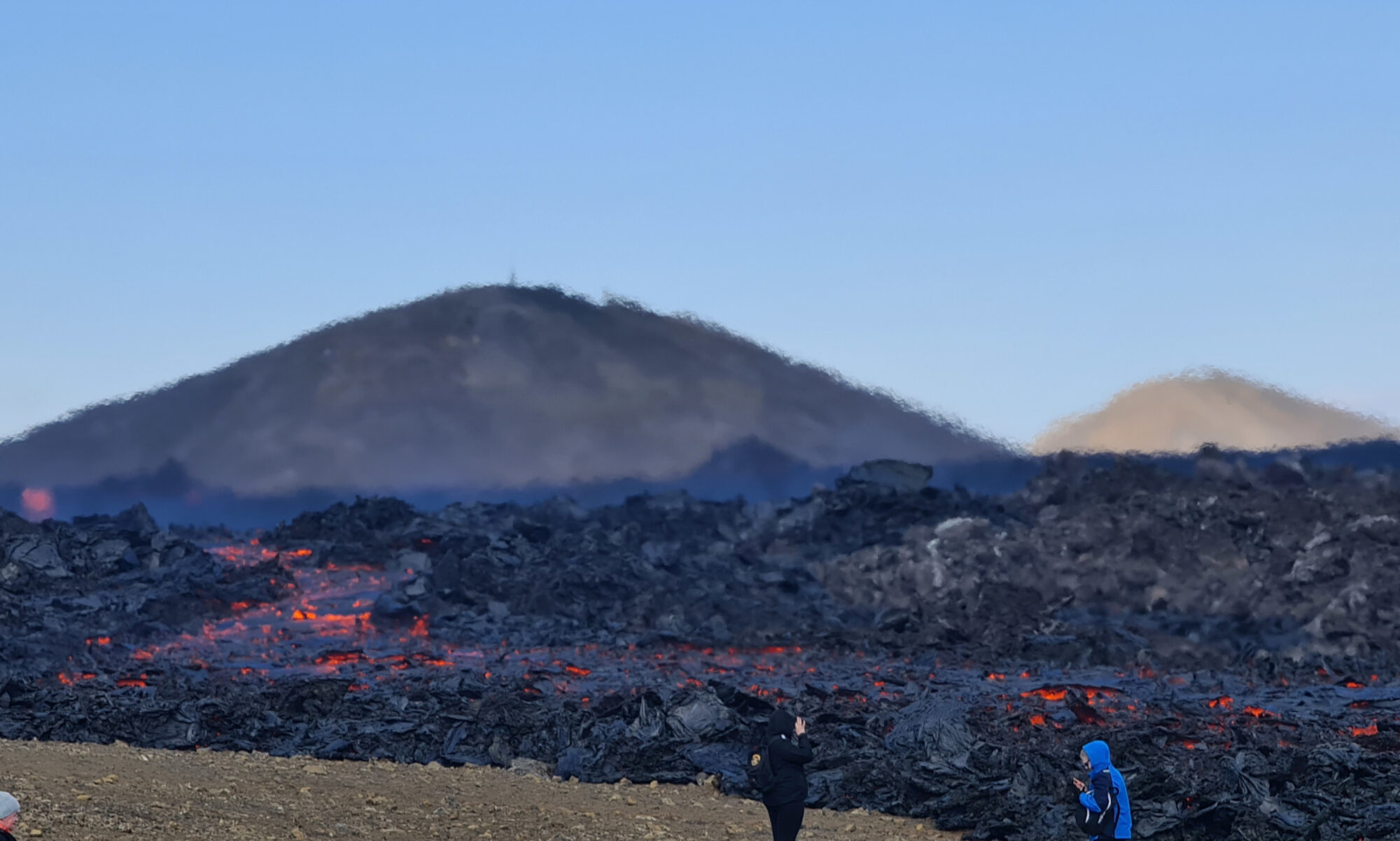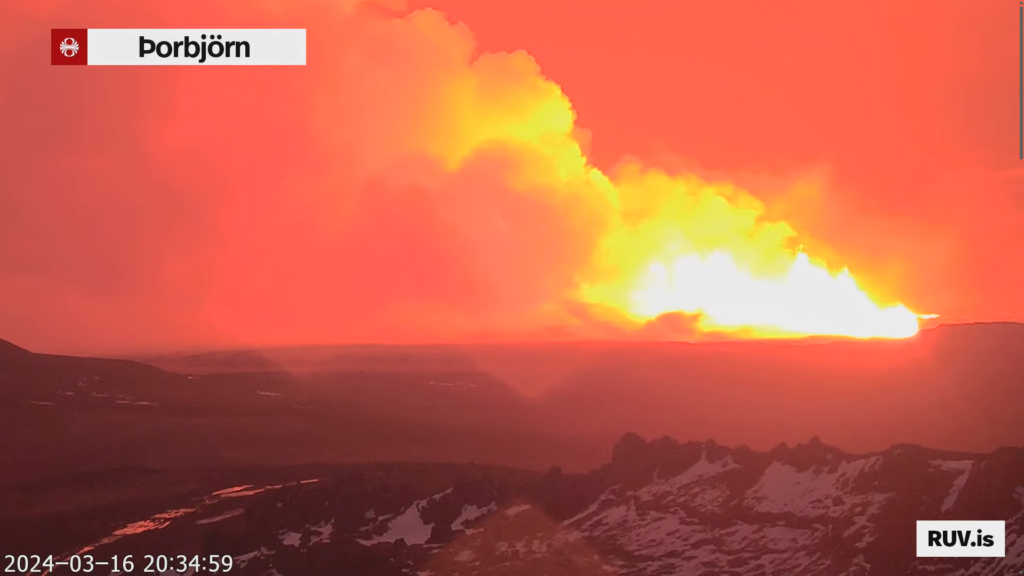Eruption is about to start in Svartsengi volcano in Sundhnúkagígar area. This is unlikely to be a dyke intrusion event only. I’ll post update once the eruption has started.
Earthquake activity in Reykjanes volcano
Today (22. April 2024) at 04:53 UTC an earthquake swarm started in Reykjanes volcano. This was not a strong or a large earthquake swarm. Largest earthquake only having a magnitude of Mw3,1. All other earthquakes where smaller in magnitude.
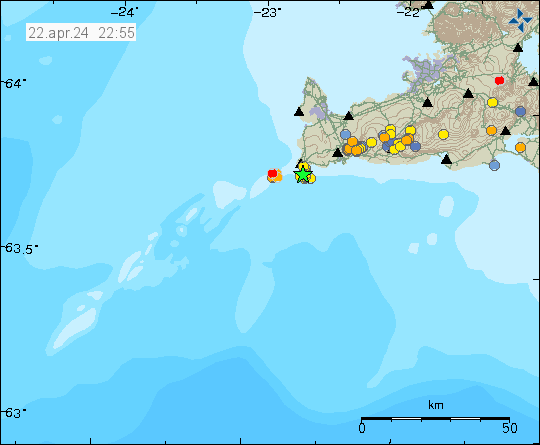
This earthquake activity suggest a magma movement. It is however too little to start an eruption at the writing of this article. That can change without warning. Since the condition that the Reykjanes volcano is in is unclear, since its in part under the ocean and that makes monitoring it properly difficult and impossible in some areas.
Earthquake swarm in Askja volcano
Today (25. March 2024) starting at 08:06 UTC and ending around 11:00 UTC an earthquake swarm started in Askja volcano. The largest earthquake in this swarm had a magnitude of Mw3,5. The area is remote and this earthquake was not felt.
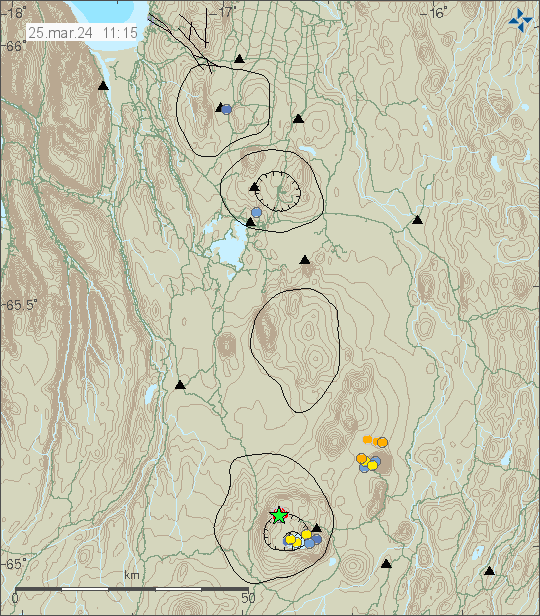
This earthquake activity suggests that this was a dyke intrusion. Eruption is unlikely at the moment in Askja volcano. This activity might be the first indicators that Askja volcano has started to prepare for an eruption in the future. When is impossible to know.
Update on the eruption in Sundhnúkagígar (Svartsengi volcano) on 17. March 2024 at 18:28 UTC
This is a short update because I don’t expect a lot to happen in this eruption.
Here are the main details as they are known on 17. March 2024 at 18:28 UTC. This is the best information I have at current time.
- The eruption has gotten smaller since it started yesterday (16. March 2024 at 20:23 UTC). The fissure is now only erupting in three to four locations.
- The lava field did reach the barriers that are protecting Grindavík town.
- This eruption is not slowing down as quickly as earlier eruptions.
- Harmonic tremor is mostly consistent but is lower than yesterday when the eruption started.
- The eruption fissure seems to be around 800 meters to 1 km long.
- There’s a ongoing risk of new fissures opening.
- Lava flow seems to have slowed down, but that might because it might be collecting in large lava ponds that break and then the lava rushes forward at great speed.
- Suðurstrandarvegur is at risk of getting buried by a lava flow. If that happens, the risk of the lava reaching the ocean increases, since from the road the distance is only around 500 meters.
- There’s no signs of this eruption ending on the web cameras.
- Craters have started forming in the active parts of the fissure.
If anything more happens I’ll post update soon as I can. Normally, an eruption from Svartsengi volcano only last around 1 day. If this eruption goes longer, then next update should be tomorrow or sooner if anything important happens.
Eruption has started in Sundhnúkagígar in Svartsengi volcano
Dyke intrusion into Sundhnúkagígar from Svartsengi volcano yesterday (02. March 2024)
Yesterday (02. March 2024) at 15:57 UTC an earthquake swarm started in Sundhnúkagígar, all earthquakes where small in magnitude and around 150 where recorded. This earthquake swarm was as sign of a dyke intrusion that was starting into Sundhnúkagígar. It did not result in a eruption, but might be a sign of where next eruption is going to happen, when it happens. The dyke intrusion ended around 17:57 UTC.
This is a bit early, but it seems that this dyke intrusion moved or changed the rift valley it happened in. This rift valley was created in the dyke intrusion on 10. November 2023 (Icelandic Met Office has a image of it here). It might also have moved the rift valley that was created on 14. January 2024 (image of that rift valley can be found here, its marked with a blue colour). This rift valley situation is making the geology in this area extremely complex and volatile. Since the crust, the top layer is extremely fractured in areas of the rift valley and that makes it easy for the magma to find a path to the surface.
It is impossible to know when next eruption is going to happen. But it is my own estimated that next eruption might happen between 3. March to 5. March. I might be wrong on this, that’s always an possibility.
Increased risk of an eruption in Sundhnúkagígar or nearby area from today (22. February 2024) and until eruption happens
I am sorry for slow updates. All this activity and eruptions keeps me busy with many things. I also needed a little break from writing articles.
According to Icelandic Met Office and what I’ve been seeing on GPS data from around Svartsengi volcano an eruption is expected possibly next week, it might happen earlier or later, there’s no way to be sure on this. But the inflation has reached the same level just before the eruption on 8. February 2024. What is going to happen in next eruption is impossible to know, until the eruption starts. There is ongoing risk that next eruption is going to happen closer to Grindavík town and not in Sundahnúkagígar area as the eruption on 8. February 2024 took place.
At the current rate, there’s going to be an eruption in Sundhnúkagígar area every 30 or so days until something changes. When that happens is impossible to know. This 30 day eruption cycle might go on for a long time, even many years.
Update on the eruption at Sundhnúkagígar at 22:41 UTC on 8. February 2024
This is a short update on the eruption at Sundhnúkagígar.
- Four hour GPS data shows that inflation has already started in Svartsengi volcano, that is currently erupting. This inflation seems to have started soon as the eruption started to get lower around 13:00 UTC.
- The lava flow damaged the hot water pipe from Svartsengi power plant and now around 26.000 people on the Reykjanes peninsula are without hot water. There is also some damage to the power infrastructure, but that is minimal and that power has been restored on the power lines that are next to the lava flow. The situation on the cold water is unclear, but it was at risk of damage.
- This eruption was larger compared to the eruptions on 18. December 2023 and on 14. January 2024.
- Small ash cloud formed today and the reason for that, according to experts in the news. Was that the eruption in part of the fissured ended so suddenly with a pressure drop that the fissure walls collapsed, allow ground to get in touch with lava and then ground water started to flow on the lava. Resulting in two clouds, one dark and a steam cloud. This was large for an about hour or two. Steam cloud was ongoing at writing of this article, but darkness prevents me from seeing if this has stopped. It is likely though.
- The eruption is ongoing in two to three craters at the writing of this article.
- It is expected, based on current rate of how much the eruption is slowing down that it is going to end tomorrow, 9. February or on 10. February.
- Next eruption is going to be in March around 6th to 18th March if current pattern holds for Svartsengi volcano. There’s nothing to rule out that a new eruption might happen sooner. It is impossible to know what happens next in Svartsengi volcano eruptions.
If anything more happens. I’ll post update soon as I can.
Eruption started in Sundhnúkagígar at 06:02 UTC on 8. February 2024
This morning (08. February 2024) at 06:02 UTC an eruption started close to Sundhnúkagígar, close to the area where the eruption started on 18. December 2023. The eruption fissure is at the writing of this around 3 km long, but the fissure is getting longer, based on views from web cameras.
This eruption is at favourable location. Since its far way at the moment from all buildings and infrastructure. That might change if the fissure stretches more to the south. This eruption started really quickly, according to Rúv, from the start of the earthquake swarm until the eruption started the time was only about 30 minutes. The time this took on 18. December 2023 was 60 minutes.

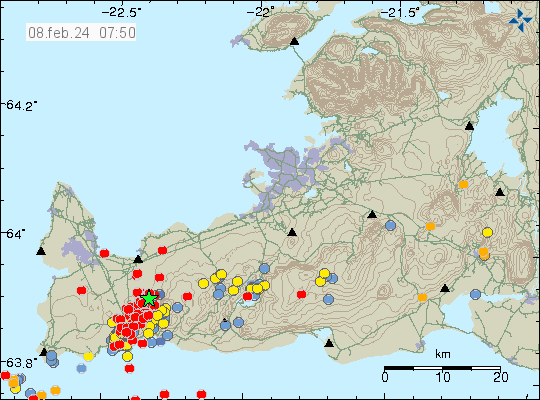

I’ll post more information later today when it is clear how this eruption is progressing.
Earthquake activity in Brennisteinsfjöll volcano (Bláfjöll)
Yesterday (26. January 2024) and today (27. January 2024) an earthquake activity took place in Brennisteinsfjöll volcano, in the Bláfjöll area. The first earthquake had a magnitude of Mw2,4 at 22:54 UTC on 26. January 2024 and the second earthquake had a magnitude of Mw3,1 on 27. January 2024 at 05:28 UTC. Smaller earthquakes started later today. That earthquake activity seems to have ended at the writing of this article.
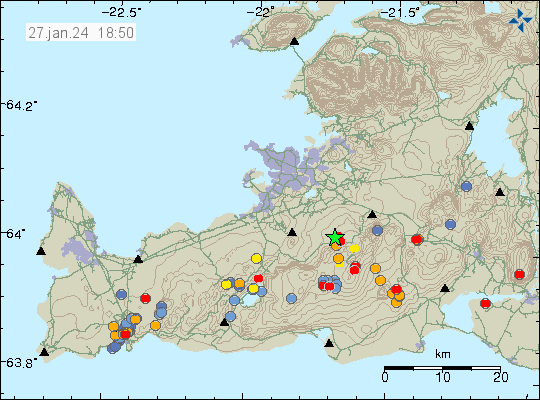
This earthquake activity, at least in the case of the Mw2,4 and Mw3,1 earthquake did show a sign that they where created by magma movement, among those signs was a strong vertical movement and low period signal that only happens when magma creates earthquake. At this point in time, I don’t think an eruption is going to happen any time soon. It is possible that magma has started to collect in Brennisteinsfjöll volcano. It is going to be several years until something more happens, it might even take decades before anything serious happens.
